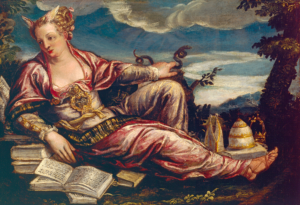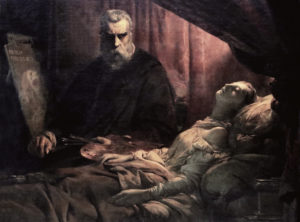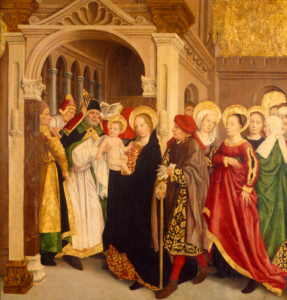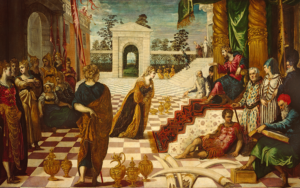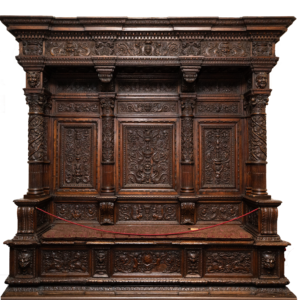At the dawn of the 16th century Mannerism was gaining in popularity. Even noted Renaissance painters like Raphael began to mirror the style, but it was the Sienese painter Giovanni Antonio Bazzi who would push the mannerist vision even further.
Tag Archives: Renaissance
The Visit of the Queen of Sheba to Solomon
Oil on Canvas
Jacopo Robusti, called Il Tintoretto
Venetian, 1519-1594
Allegory of Wisdom
Oil on Canvas
Marietta Robusti, called La Tintoretta
Venetian, c. 1554- c.1590
Jacopo Robusti, better known by his nickname, Il Tintoretto, was one of the most sought after and prolific painters in sixteenth-century Venice. He never lacked for commissions throughout his life and produced some of the city’s most famous canvases. The Visit of the Queen of Sheba to Solomon from the Museum & Gallery collection is one of his early works.
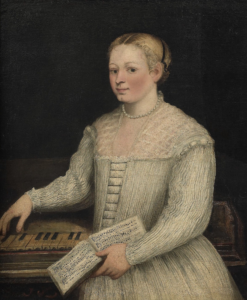 Jacopo’s success was in part due to his bustling family workshop which included two of his sons and Marietta his daughter, painter of M&G’s Allegory of Wisdom. In an article on Marietta, Louise Arizzoli points out that “Our reading of Renaissance masters as individual geniuses that started with Vasari’s Lives, sheds a negative light on those collaborators who remained in the shadow of the leading artist. These family workshops have however to be understood as teamwork, in which every member had specific responsibilities in order to ensure the quality of the commissions. Therefore, it is particularly difficult for us now to recognize individualities, as it was not the aim of the workshop to enhance individual style but to produce a certain style—that of Tintoretto” [Italics added]. This is one reason that apart from a small number of religious paintings and the Self-Portrait above (now in the Uffizi) few works are definitively assigned to Marietta. In addition, her talents were a close match to her father’s. This is especially evident in the figural details and similarities of brushwork and coloration in the two M&G works showcased.
Jacopo’s success was in part due to his bustling family workshop which included two of his sons and Marietta his daughter, painter of M&G’s Allegory of Wisdom. In an article on Marietta, Louise Arizzoli points out that “Our reading of Renaissance masters as individual geniuses that started with Vasari’s Lives, sheds a negative light on those collaborators who remained in the shadow of the leading artist. These family workshops have however to be understood as teamwork, in which every member had specific responsibilities in order to ensure the quality of the commissions. Therefore, it is particularly difficult for us now to recognize individualities, as it was not the aim of the workshop to enhance individual style but to produce a certain style—that of Tintoretto” [Italics added]. This is one reason that apart from a small number of religious paintings and the Self-Portrait above (now in the Uffizi) few works are definitively assigned to Marietta. In addition, her talents were a close match to her father’s. This is especially evident in the figural details and similarities of brushwork and coloration in the two M&G works showcased.
 These mysteries of attribution are not only on-going but truly fascinating. For example, many scholars believe that several of Marietta’s works may simply have been incorporated into her father’s oeuvre. For example, Old Man and a Boy (Kunsthistorisches Museum) was considered one of Jacopo’s best portraits, but in 1920 Duncan Bull, a curator at the Rijksmuseum, reassigned the attribution to Marietta on the basis of the ‘M’ signature discovered on the work. (The ‘M’ is in the lower right of canvas beside the chair arm.) However, there are still scholars reluctant to accept this re-attribution.
These mysteries of attribution are not only on-going but truly fascinating. For example, many scholars believe that several of Marietta’s works may simply have been incorporated into her father’s oeuvre. For example, Old Man and a Boy (Kunsthistorisches Museum) was considered one of Jacopo’s best portraits, but in 1920 Duncan Bull, a curator at the Rijksmuseum, reassigned the attribution to Marietta on the basis of the ‘M’ signature discovered on the work. (The ‘M’ is in the lower right of canvas beside the chair arm.) However, there are still scholars reluctant to accept this re-attribution.
Two other important biographers detailing Tintoretto’s (and by extension Marietta’s) career are Raffaele Borghini (1537-1588) and Carlo Ridolfi (1594-1658). Both writers note that Marietta was not only exceptionally talented but also her father’s favorite. In his Le Maraviglie dell’Arte Ridolfi writes:
Marietta Tintoretto, then, lived in Venice, the daughter of the famous Tintoretto and the dearest delight of his soul. He trained her in design and color, whence later she painted such works that men were amazed by her lively talent. Being small of stature she dressed like a boy. Her father took her with him wherever he went and everyone thought she was a lad. She made a portrait of Jacopo Strada, the antiquarian of Emperor Maximilian, who presented it to his majesty as a rare work, whence the emperor, charmed by her valor, made enquiries about her of her father. Philip II, the King of Spain, and Archduke Ferdinand also asked him about her. However, Tintoretto was satisfied to see her married to Mario [Marco] Augusta, a jeweler, so that she might always be nearby, rather than be deprived of her, even though she might be favored by princes, as he loved her tenderly […] When she died her father wept bitterly, taking it as the loss of a part of his own inner being.
Marietta died four years before her father around 1590. The exact cause of her death is uncertain, but many believe she died in childbirth. Regardless, Ridolfi’s account of the close personal and professional relationship between the two would blur “into the myth of a young and talented woman painter who died too soon, leaving her father heart-broken.” We do know that Jacopo’s output began to fall off after his daughter’s death—whether because of grief or because of the loss of collaborative talent cannot be known. In any case, she would eventually become a muse for 19th century painters. Léon Cogniet’s Tintoretto Painting his Dead Daughter is perhaps the most famous among these Romantic paintings.
Donnalynn Hess, Director of Education
Published in 2021
Paris Bordone studied for a time under Titian, the greatest Venetian artist of the 16th century. Although forced to leave this great master’s studio, Bordone went on to excel in portraiture, large-scale architectural settings, and cabinet paintings.
This elegant tondo illustrates the interesting “detective” work that is sometimes involved in attributing a work of art to a particular artist.
The Presentation of Christ in the Temple
Tempera on canvas, monogrammed and dated 1490 (lower left on base of column)
Antoine de Lonhy, called the Master of the Trinity of Turin
French (active in Spain and Flanders), c. active 1460–1490
French-born Antoine de Lonhy painted this vibrant scene around 1490. Although he trained in the Burgundy region of France, de Lonhy spent parts of his early career in Toulouse and Barcelona. He worked his later years in what is today the Piedmont and Aosta Valley regions of Italy. For many years, de Lonhy’s identity remained a mystery, and he was known only as the Master of the Trinity of Turin. Only in the past 20 years have scholars been able to identify de Lonhy and associate his name with his varied body of work. De Lonhy was a true Renaissance man whose work included panel paintings, illuminated manuscripts, frescoes, and stained glass, as well as textile and sculpture designs.
The Presentation of Christ in the Temple was originally painted on panel and at some point, transferred to canvas. M&G’s painting is believed to have been part of a large, lost altarpiece of a church in Piedmont. Another of de Lonhy’s works, Mort de la Verge, displays the same raised gold-leaf technique as well as similar colors and patterns to M&G’s Presentation. It is possible that both panels were once part of the lost altarpiece. De Lonhy’s masterful skill shines in all the details of this work, especially in his pristine architectural elements. The raised gold-leaf, particularly on the halos and borders of the garments, provides texture and dimension. His use of vibrant colors and patterns beautifully illustrates the joyfulness of the occasion. Mary lovingly presents the Christ Child to the priest while Joseph looks on carrying their offering of two turtledoves. Ironically, de Lonhy clad Mary and Joseph in rich, brocade garments which contrasts with the turtledoves, the offering of the poor.
Luke 2:22-40 illuminates the narrative of this scene. Jewish law required a woman to be purified 40 days after giving birth to a son. The mother was required to bring an offering of a year-old lamb or two young pigeons or turtledoves (for those who could not afford a lamb). This offering was presented to the priest who sacrificed them before the Lord to make atonement for the mother (Leviticus 12:1-8). The law of Moses also required the consecration of every firstborn male. In accordance with the law, Mary and Joseph traveled to the temple in Jerusalem to present Christ for consecration. Luke tells of the priest, Simeon, who was promised “by the Holy Spirit that he would not die until he had seen the Lord’s Messiah.” De Lonhy captures the moment when that promise to Simeon was fulfilled: Mary presented the Lord’s Messiah to Simeon for consecration leading Simeon to respond with praise to and adoration of God. Simeon witnessed with his own eyes God’s fulfillment of His promise.
Rebekah Cobb, Registrar
Published in 2021
Francesco Granacci’s Rest on the Flight into Egypt is an excellent example of the High Renaissance style.
Seat of State
Walnut
Italian, 16th century
A throne is usually a large, ornate chair designed to impress. The majesty and power of the one seated on the throne is visually communicated by the throne’s magnificence. Thrones are also designed to intimidate the one who stands, kneels or bows before the one seated upon it. Today the judge’s bench of a courtroom and the dais of an assemblies’ chairman are designed to have a similar effect.
Technically a high backed, multi-seat bench is a settle. Settles generally have arms, and elaborate ones often have canopies. They are generally stationary and may be an architectural feature built into a room. A settee is the settle’s smaller, movable cousin. Today’s couch, sofa or love seat can be called a settee.
In the 15th and 16th centuries various kinds of settles were used in Italian city-states for ceremonial purposes. In the Chamber of the Great Council of the Doge’s Palace in Venice, massive, built-in settles surround the room. Along the front wall is a raised seven-seat settle for officials of the Maggior Consiglio. The central, larger, higher seat was for the Doge.
The three seat Throne of Giuliano Dei Medici (son of Lorenzo the Magnificent) is very similar to M&G’s Seat of State. Although the provenance of Giuliano’s throne is not clear, most likely it originated in Florence. Another elaborate three-seat throne, attributed to Bartolomeo Baglioni, was probably made in the early 1500s for the Strozzi family of Venice (now currently in the Ringling Museum).
Other than the Seat of State being crafted in Italy in the 16th century, its origin is unknown. But similarity to these and other examples, give credence to it having served as the ceremonial seat of an Italian, high-ranking, three-person governmental body.
M&G’s Seat of State lacks features that would associate it with a particular city or individual. The rich profusion of intricate carvings reflects scrolling foliage, mythical beings, grotesque masks and geometric embellishments. There are small crests, but they appear to be stylized ornaments rather than official symbols. Also, they are not located in prominent places where identifying crests could be recognized and appreciated by those in front of the settle.

The stylized crests are not in the prominent places where one would expect to find official crests (center image). Highly skilled craftsmen embellished M&G’s massive settle with ornate details (left-right images).
The choir stall, also represented in M&G’s furniture collection, is similar to a settle. Choir stalls generally have uniform, narrow seats. Their high backs and canopies are more for acoustics and aesthetics of the room than aggrandizement of the individuals seated on them. Choir stall seats are often collapsible, permitting the choir to stand or kneel during religious services. The visible carvings of a choir stall generally have religious themes with geometric ornamentation.
The Seat of State is constructed of interlocking pieces of solid walnut fitted together with mortise and tenon joints. The seat is a chest, and each person sits on a hinged lid. Because of the height and depth of the seat, unless you have long legs, you must sit forward on the bench, which makes the back too far away to rest comfortably. The settle’s lack of comfort might have helped to keep ceremonies and meetings short.
Standing in front of M&G’s 10’ high, ornately carved, polished red-brown Seat of State one is impressed with its magnificence. Now, envision being led into that position while three officials in their elaborate ceremonial garb sat on those seats and stared down at you. Will they grant your petition? Will they decide in your favor? Whatever they do, you just know they have the power and authority to do it.
It worked. That is exactly what this settle was to settle in your mind.
William Pinkston, retired educator and M&G volunteer
Published in 2020
During the 500th anniversary marking Martin Luther’s nailing of his 95 theses to the door of Wittenberg’s chapel, M&G created an exhibition exploring his life and continuing influence. This video from that exhibition focuses on his musical legacy.
The European furniture in the Museum & Gallery collection has been called the finest in America by Joseph Aronson, author of The Encyclopedia of Furniture. This beautiful Italian cassone is a good example.

